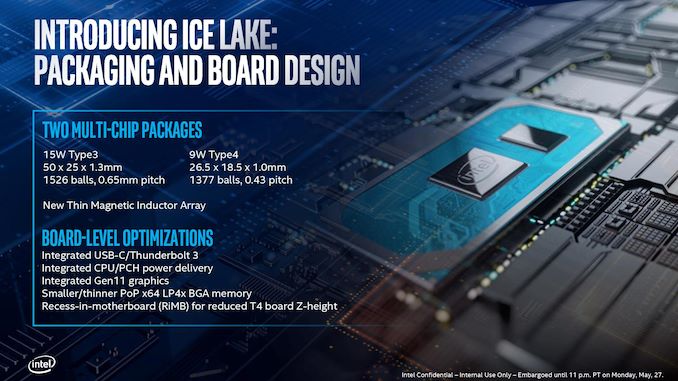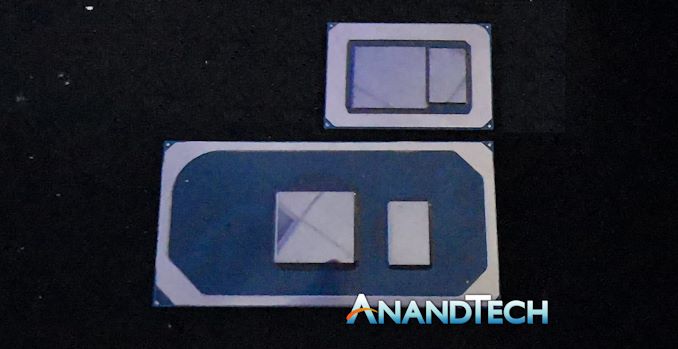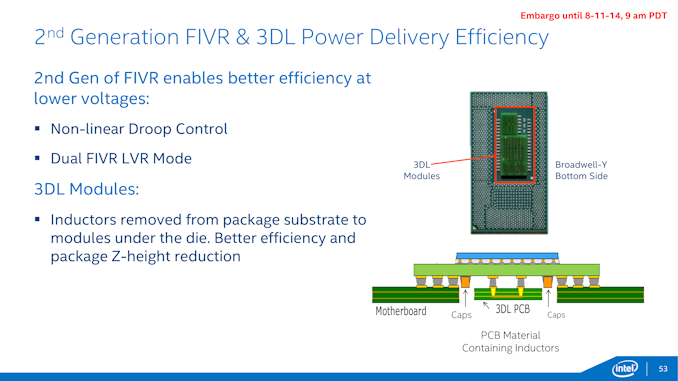Examining Intel's Ice Lake Processors: Taking a Bite of the Sunny Cove Microarchitecture
by Dr. Ian Cutress on July 30, 2019 9:30 AM EST- Posted in
- CPUs
- Intel
- 10nm
- Microarchitecture
- Ice Lake
- Project Athena
- Sunny Cove
- Gen11
Two Versions, Two Different Power Targets
Intel has promised that Ice Lake-U will be seen in a variety of form factors, targeting anywhere from 9W to 28W. This sort of range is not new for a U-series processor – we typically see overlap from something lower down (the Y-series, ~5W) or higher up (H-series, ~45W), however Ice Lake hasn’t currently been listed for H series power budgets - only Y and U. Having such a wide window, from 5-28W, allows Intel to be very wide with binning the chips as they come of the production line, which is a very valid tactic for promoting as much yield as possible with minimal waste.
Technically there will be two different Ice Lake BGA mobile packages – one aimed at low power (7-12W) for the Y series, and another for higher power designs (15-28W) in the U series.
At this point Intel has not stated what core configurations will be in both packages, however it is likely that the lower power 7-12W ‘Type 4’ package will be for Y-series implementations only, especially given that the overall package size is only 490mm2 (26.5x18.5) compared to 1250 mm2 (50x25), making it 39% the size of the larger high power package. It stands to reason then that the smaller package is for lower performance and low power options, despite being exactly the same silicon.
This Type-4 option also uses the ‘recessed in board’ design we first saw with Broadwell-Y, which is required based on the integrated voltage regulators that Intel now uses on its low powered designs. This makes a very interesting point about Intel’s capabilities with low powered 10nm designs: one could postulate that as the recessed model is well above the traditional Y-series power line. If the 10nm process doesn’t go low down enough in power to that sub-5W range, it could either be because of power, or there isn't enough frequency for Intel to actually sell at volume. Alternatively Intel could end up increasing the base power of the Y-series. One could draw parallels with the first generation 10nm Cannon Lake Core i3-8121U at 15W, which was initially postulated to be dual-core Y-series silicon, rather than the 15W U-series designation it ended up with (our review showed that it did indeed consume more power for the same work compared to a 14nm equivalent design, which would imply a very high static power). With this in mind, it makes me wonder what percentage of Type 3 / Type 4 package designs Intel will end up shipping into the market.
Broadwell Motherboard Design for Recessed Power Implementation
Intel is keen to promote that one of the new features of Ice Lake is its Thin Magnetic Inductor Array, which helps the FIVR achieve better power conversion efficiencies and waste less power. The main issue with a FIVR is at low power consumption states that have a lot of inefficiency – some other processor designs have a linear LDO (Low-Dropout Regulator) implementation which is better for low power designs but less efficient in high power modes.













107 Comments
View All Comments
Billy Tallis - Wednesday, July 31, 2019 - link
A lot of the chemicals used in wafer processing are quite nasty. A bare wafer itself is pretty harmless unless you grind it up and inhale it. Solid elemental silicon or silicon dioxide is safe to handle.repoman27 - Tuesday, July 30, 2019 - link
I understand that there are embargos which must be respected and that Anandtech does not like to trade in unsubstantiated rumors, but much of what is presented regarding packaging and power seems a bit wishy-washy.Wikichip has had photos of both sides of the Ice Lake U and Y packages posted for some time now. Furthermore, Intel's product briefs are very clear on the power for each series:
Ice Lake Y: Nominal TDP 9 W, cTDP Down 8 W on Core i3 only, cTDP Up 12 W but N/A on Core i3,
Ice Lake U: Nominal TDP 15 W, cTDP Down 12 W (13 W for some UHD parts), cTDP Up 25 W
AFAIK, no 28 W Ice Lake-U parts have been announced by Intel yet, but they most likely are in the works.
And you can cite whatever reasons you care to, but by all reports Intel was initially targeting a 5.2 W TDP for Ice Lake-Y 4+2, and that entire platform has been solidly shifted into the 8-12 W range.
Also, it should be noted that the 14nm 300 Series chipsets that Intel has been shipping for some time now are all Cannon Point, which was originally designed to complement Cannon Lake, and are almost identical in terms of capabilities to the 400 Series. And the particular designation for the Ice Lake PCH-LP according to Intel is "495 Series".
James5mith - Tuesday, July 30, 2019 - link
Ian,You either have your graph or your paragraph about the store/load performance increases reversed.
Graph says 72 -> 128 stores, 56 -> 72 loads. The paragraph below it says 72-128 loads, 56-> 72 stores.
ksec - Tuesday, July 30, 2019 - link
While I do enjoy and mostly want to read Dr Ian Cutress article, I seriously don't want to read Intel's marketing hype. Action and Results speaks louder than Powerpoint slides. Ship it, let Anandtech test it. And we make an opinion on it.Targon - Tuesday, July 30, 2019 - link
The Ryzen 7 3700U is a Zen+ part on 12nm, without the big IPC plus clock speed improvements seen with the desktop CPUs. As a result, Intel is doing a comparison against the previous generation products for laptops.In laptops, getting max turbo or boost for more than one second is rare. Yea, Intel can put a laptop chip on a board on a bench without any enclosure to show the chip, but real world speeds will be quite a bit lower. That is true for both AMD as well as Intel, and it is up to the OEMs to come up with a design to keep the chips cool enough to run faster than the competition.
AMD knows what is going on, so if I am correct, AMD will move up the release of the next generation of laptop chips to November. If AMD does the right thing, AMD will call the new chips the 3250U, 3400U, 3600U, and 3800U to bring consistency with desktop naming conventions. These new chips would be 7nm with either Vega or Navi, for an APU it is less important than going 7nm for both.
Drumsticks - Tuesday, July 30, 2019 - link
Keep in mind, the only comparison they did with Ryzen (I think) was Graphics, not CPU. I'd imagine the Icelake chips have a solid CPU lead against quad core Ryzen based on Zen/Zen+. Zen 2 will certainly help close that gap, but it should still be roughly 15-20% behind Icelake in IPC, and I certainly won't be ahead that much on frequency.Fulljack - Wednesday, July 31, 2019 - link
I think in Q4 19 they'd release Ryzen 4000 series (based on Zen 2) and call it day, like last year or two year ago.they'll be 4300U, 4500U, and 4700U for U-series and 4350H, 4550H, and 4750H for high-performance part with integrated graphics based on Navi.
but since Zen 2 has 8 cores now on each CCX, they'd probably also sell 6-core and 8-core part, but I don't know if they'll release it on U-series, though.
Apple Worshipper - Tuesday, July 30, 2019 - link
Thanks Ian ! So how does Ice Lake purportedly stand next to Apple’s A12x in iPad Pro based on the Spec scores ?PeachNCream - Tuesday, July 30, 2019 - link
More importantly, how does Ice Lake taste?HStewart - Tuesday, July 30, 2019 - link
I have seen anything that was successfully comparing x86 based cpus with AEM based cpusBut one things - that makes all this MacBook ARM stuff meaningless to me is one sheer fact - Apple has yet to release development tools for iOS on actual iOS. It might be Apple trying force Macs for development but Apples own development tools don't run on iOS